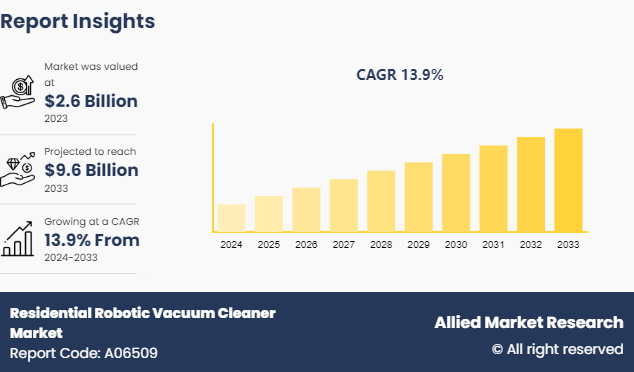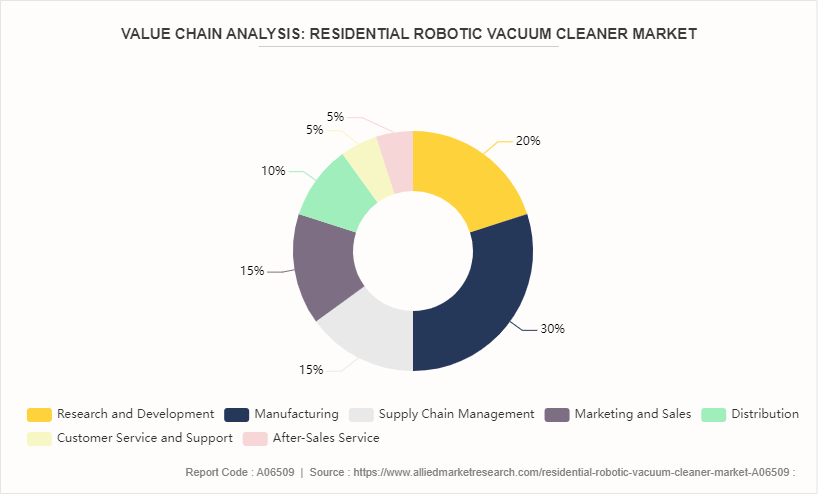Residential Robotic Vacuum Cleaner Market Research, 2033
The global residential robotic vacuum cleaner market size was valued at $2.6 billion in 2023, and is projected to reach $9.6 billion by 2033, growing at a CAGR of 13.9% from 2024 to 2033.

Market Introduction and Definition
A residential robotic vacuum cleaner represents an automated, self-navigating machine used for cleaning floors in homes, often equipped with sensors, brushes, and vacuum capabilities for collecting dust and debris. The market for these gadgets is being driven by trends such as rising consumer demand for smart home technologies, the simplicity and time-saving benefits of automation, advances in AI and machine learning to enhance navigation and cleaning effectiveness, and growing awareness of hygiene and cleanliness, particularly in the context of recent global health issues. Furthermore, improvements such as the incorporation of voice assistants, increased battery life, and lower prices are driving the residential robotic vacuum cleaner market growth.
Key Takeaways
The residential robotic vacuum cleaner market study covers 20 countries. The research includes a segment analysis of each country in terms of value ($Million) for the projected period 2024-2033.
More than 1, 500 product literatures, industry releases, annual reports, and other such documents of major residential robotic vacuum cleaner industry participants along with authentic industry journals, trade associations' releases, and government websites have been reviewed for generating high-value industry insights.
The study integrated high-quality data, professional opinions and analysis, and critical independent perspectives. The research approach is intended to provide a balanced view of global markets and assist stakeholders in making educated decisions to achieve their most ambitious growth objectives.
???????Key market dynamics
The growing usage of smart home technology is a primary driver, as customers seek to integrate linked devices for more ease and effectiveness in domestic duties. Technological breakthroughs in artificial intelligence (AI) and machine learning are enhanced robotic vacuum navigation, obstacle recognition, and cleaning efficiency, making them more effective and attractive. Furthermore, there is a rising awareness of the need to keep a clean and sanitary living environment, especially in the aftermath of global health problems like the COVID-19 pandemic, which has increased consumer attention towards cleanliness. Improved battery life, connection with voice assistants such as Amazon Alexa and Google Assistant, and the capacity to handle various floor types and pet hair are all garnering a larger consumer base. These factors are defining an upward trajectory of growth for the global residential robotic vacuum cleaner market share.
Despite favorable market conditions, the residential robotic vacuum cleaner sector confronts various barriers to expansion. One key constraint is the high starting cost of sophisticated models, which might be a deterrent for price-sensitive customers. While there are various reasonable choices, the most economical and feature-rich equipment is?expensive. A further challenge is technological limitations in the performance of robotic vacuums as compared to regular vacuum cleaners, particularly in homes with complicated layouts, many floors, or numerous obstructions. Battery life and the necessity for regular recharging might further restrict the usefulness and convenience of those gadgets, especially in bigger households. Finally, competition with conventional vacuum cleaner producers, who are always innovating to increase efficiency and convenience, offers a barrier to the broad acceptance of robotic vacuums. These constraints provide important obstacles that the sector must overcome to continue and expand its growth.
Value Chain of Global Residential Robotic Vacuum Cleaner Market
Research and Development (R&D) : This initial phase entails intensive research and development to create robotic vacuum cleaners using advanced capabilities including navigation systems, obstacle recognition, and enhanced cleaning processes.
Manufacturing: The manufacturing of robotic vacuum cleaners includes assembly, evaluations, and quality control.
Supply Chain Management: Handling the supply chain includes obtaining supplies, components, and components from vendors and managing logistics to ensure timely delivery to production plants.
Marketing and Sales: Marketing and sales initiatives seek to raise awareness, develop demand, and advertise robotic vacuum cleaners to customers using a variety of channels, including advertising, internet platforms, and retail locations.
Distribution: Distribution refers to the physical transfer of robotic vacuum cleaners from production plants to distribution centers, retailers, and, finally, customers.
Customer Service and Support: Providing good customer service and assistance is critical for establishing brand loyalty and maintaining consumer happiness.
After-Sales Service: After-sales service includes maintenance, repairs, and product updates to extend the life and efficiency of robotic vacuum cleaners.

Market Segmentation
The residential robotic vacuum cleaner market is segmented into type, distribution channel, and region. On the basis of type, the market is divided into floor vacuum cleaner, and pool vacuum cleaner. On the basis of distribution channel, the market is bifurcated into offline and online. Region wise, the market is analyzed across North America, Europe, Asia-Pacific, Latin America, and Middle East & Africa.
Regional/Country Market Outlook
In North America, particularly in the United States, the market is growing rapidly because of high consumer spending power, widespread use of smart home technology, and a strong presence of top robotic vacuum cleaner manufacturers. According to market dynamics, North America held a major market share in 2023, with the U.S.?contributing the most revenue, followed by Canada. Europe is another important location with a developed market for household robotic vacuum cleaners, headed by Germany, the United Kingdom, and France. The market expansion in Europe is being driven by a similar trend of increased smart home adoption, along with strict cleaning regulations and a focus on sustainable development.
Countries in the Asia Pacific, including China, Japan, and South Korea, are seeing significant market development as a result of technological innovation, urbanization, and growing disposable incomes. In 2023, ?Asia Pacific is primed for significant expansion, with China becoming as a prominent market participant due to its massive population and expanding middle class.
However, market adoption in other places, such as Latin America and the Middle East, is?sluggish owing to economic volatility, a lack of understanding of smart home technology, and cultural preferences for manual cleaning techniques. Overall, while regional dynamics fluctuate, the residential robotic vacuum cleaner market forecast period offers has strong global development potential, with different areas contributing to its expansion at differing rates.
Industry Trends:
The market's latest trend is the emergence of robotic vacuum cleaners, which use cutting-edge technology such as connectivity to Wi-Fi, artificial intelligence characteristics, and voice assistance. The most recent variants of robotic vacuums can interface with Alexa and Google Assistant?to comprehend and execute the given?orders.
The increase in prevalence of smart homes has been one of the primary drivers of the residential?robotic vacuum cleaner industry. In June 2022, iRobot Corp, a global consumer robot manufacturer, introduced the high-end Roomba J7+ smart vacuum cleaner equipped with iRobot OS in India. The latest smart vacuum cleaner joins the Roomba i7, S9, and i3 series, among others. The Roomba i7 series, like its previous product series, offers two models: the normal Roomba J7 and the Roomba J7+, albeit the latter model is only accessible across the nation.
Competitive Landscape
The major players operating in the residential robotic vacuum cleaner market include Ecovacs Robotic Co. Ltd, Roborock Technologies Co. Ltd, LG Electronics, Inc, iRobot Corporation, Cecotec Innovaciones SL, Neato Robotics Inc., Electrolux AB, SharkNinja Operating LLC, Panasonic Corporation, and Haier Group Corporation.
Other players in residential robotic vacuum cleaner market includes Hitachi Ltd, Samsung Electronics Co. Ltd, Xiaomi Corporation, Dyson Ltd, Yujin Robot, Co., Ltd., Hayward Industries, Inc., Pentair plc, Proscenic, Koninklijke Philips N. V., Robert Bosch GmbH, and others.
Recent Key Strategies and Developments
In October 2022, Ecovacs introduced the DEEBOT N8 2-in-1, including greater suction capacity and innovative dToF technology that provides improved cleaning effectiveness and extremely powerful suction (3000 Pa) . It covers more than 2000 square feet on a single charge and has innovative dToF technology with OZMO mopping. It uses Next-Gen laser guiding technology to scan, map, and calculate an effective cleaning path.
In August 2022, Amazon announced an agreement to purchase iRobot, the creator of Roomba robot vacuum cleaners, for USD 1.7 billion. iRobot, most recognized for its popular robotic vacuum Roomba, has subsequently expanded the range of its goods to include additional household cleaning robots like mops and lawnmowers.
In May 2022, Haier revealed its first smart vacuum cleaner technology in India, the 2-in-1 drying & wet mop Robot Vacuum Cleaner. The vacuum cleaner has 2.4 GHz Wi-Fi and Google Home Assistant, as well as smart management capabilities including the Haier smart app, voice command, and remote control.
Key Sources Referred
International Electrotechnical Commission (IEC)
Institute of Electrical and Electronics Engineers (IEEE)
Consumer Technology Association (CTA)
American National Standards Institute (ANSI)
Robotic Industries Association (RIA)
European Committee for Standardization (CEN)
International Federation of Robotics (IFR)
Japan Robot Association (JARA)
China Robot Industry Alliance (CRIA)
Underwriters Laboratories (UL)
International Organization for Standardization (ISO)
Association for Advancing Automation (A3)
European Robotics Research Network (EURON)
International Federation of Robotics and Automation (IFRA)
Korea Association of Robot Industry (KAR)
Key Benefits For Stakeholders
- This report provides a quantitative analysis of the market segments, current trends, estimations, and dynamics of the residential robotic vacuum cleaner market analysis from 2024 to 2033 to identify the prevailing residential robotic vacuum cleaner market opportunities.
- The market research is offered along with information related to key drivers, restraints, and opportunities.
- Porter's five forces analysis highlights the potency of buyers and suppliers to enable stakeholders make profit-oriented business decisions and strengthen their supplier-buyer network.
- In-depth analysis of the residential robotic vacuum cleaner market segmentation assists to determine the prevailing market opportunities.
- Major countries in each region are mapped according to their revenue contribution to the global market.
- Market player positioning facilitates benchmarking and provides a clear understanding of the present position of the market players.
- The report includes the analysis of the regional as well as global residential robotic vacuum cleaner market trends, key players, market segments, application areas, and market growth strategies.
Residential Robotic Vacuum Cleaner Market Report Highlights
| Aspects | Details |
| Market Size By 2033 | USD 9.6 Billion |
| Growth Rate | CAGR of 13.9% |
| Forecast period | 2024 - 2033 |
| Report Pages | 200 |
| By Type |
|
| By Distribution Channel |
|
| By Region |
|
| Key Market Players | Neato Robotics Inc., Cecotec Innovaciones SL, iRobot Corporation, Haier Group Corporation, Ecovacs Robotic Co. Ltd, LG Electronics, Inc, Electrolux AB, SharkNinja Operating LLC, Roborock Technologies Co. Ltd, Panasonic Corporation |
The global residential robotic vacuum cleaner market size was valued at $2.6 billion in 2023, and is projected to reach $9.6 Billion by 2033, growing at a CAGR of 13.9% from 2024 to 2033.
The residential robotic vacuum cleaner market registered a CAGR of 13.9% from 2024 to 2033.
The forecast period in the residential robotic vacuum cleaner market report is from 2024 to 2033.
The top companies that hold the market share in the residential robotic vacuum cleaner market include Ecovacs Robotic Co. Ltd, Roborock Technologies Co. Ltd, LG Electronics, Inc, iRobot Corporation, and others.
The residential robotic vacuum cleaner market report has 2 segments. The segments are type, and distribution channel.
Loading Table Of Content...



